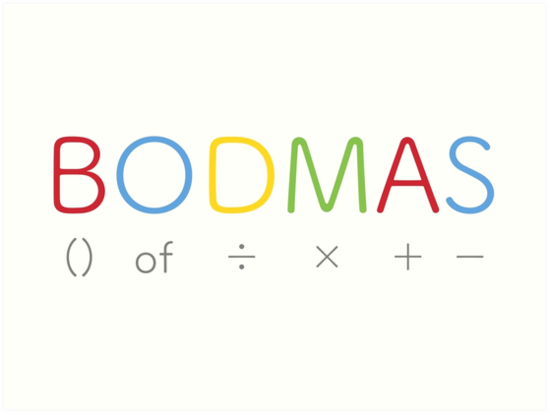Now our basic understanding of mathematical operations is strong. We know how to add, subtract, multiply and divide even large numbers. But how do we solve a question that involves all of these operations? Come let us find out using the BODMAS rule.
Suggested Videos
Use of Brackets
First, we must understand the use of brackets in mathematics. It is a very important part of forming and solving equations. Let us take an example. You went to the store to buy chocolates. You went a little overboard and bought ten chocolates. Two of them cost Rs. 10/- each, seven of them were Rs 5/- each and one was for Rs 30/-. Now how will you represent this mathematically?
Well the equation will go something like this
2 × 10 + 5 × 7 + 1 × 30 = 85
Understand more about Operations on Numbers here
However doesn’t the above equation seem very confusing? And if someone was asked to solve it he would be prone to errors and miscalculations. So let us conjure a better way of forming this equation using brackets.
(2 × 10) + (5 × 7) + (1 × 30) = 85
Doesn’t this make much more sense? It is an organized and systematic representation of the scenario. And the person solving the equation will have a better understanding as well. So you can see how the use of brackets is quite essential in mathematics.
Browse more Topics under Knowing Our Numbers
- General Form of Numbers
- Forming the Number from Given Digits
- Comparing Numbers
- Roman Numbers
- Operations on Numbers
- Estimation
BODMAS
 (Source: redbubble)
(Source: redbubble)
Now moving on to the BODMAS rule. In the above equation, we saw that we were performing two operations, namely addition and multiplication. But imagine that in an equation you had to perform more such operations. It would be confusing. And which operation will you perform first? Take for example the following equation.
23 × 7 + 78 ÷ 2 = ?
So how do you solve such a problem? This is where the BODMAS rule comes in. It gives us an order in which to perform the mathematical operations in a given problem or equation. It is actually an acronym and goes as follows
- B: Brackets
- O: Of
- D: Division
- M: Multiplication
- A: Addition
- S: Subtraction
Learn more about Roman Numerals here in detail
This is the order in which you perform the operations to arrive at the correct answer. You first solve the operations within the bracket. This is called “opening the bracket’. Then you move on to division, after which you perform multiplication if the equation requires it from left to right. And finally, you add the numbers and lastly perform the subtraction.
The best way to understand the BODMAS rule is through examples. So let us see a few problems and solve them using BODMAS.
Solved Examples
Q: Solve and find the value of x using BODMAS rule.
42 ÷ 2 + x × 3 − 22 = 8
- 2
- 5
- 4
- 3
Sol: 42÷2+x×3−22=8
⇒ 21 + 3 × x = 8 +22 = 30 ( Using BODMAS rule)
⇒ 3 × x =30 − 21 = 9
⇒ x = 9/3 = 3
Q: Simplify 3+3 of 3÷3 of 3×3 .
Sol: Applying the BODMAS rule,
3+3 of 3÷3 of 3×3
=3+(3 of 3)÷3 of 3×3
=3+9÷3 of 3×3
=3+3 of 3×3
=3+(3 of 3)×3
=3+9×3
=3+(9×3)
=3+27=30
Q: In the given equation find which of the following interchange of signs/numbers would make the equation correct 9 + 7 × 1= 5 − 3
- + with –
- + with ×
- × with –
- None of the above
Sol: The correct option is “C”.
We substitute × on the place of − and − on the place of × then the equation becomes correct
9 + 7 − 1=5 × 3
16 − 1 = 15
15 = 15
That Is true.
Question- When was BODMAS invented?
Answer– There is no definitive date for the invention of BODMAS but it appeared in writing around the early 1600s. The rules were not to be seen until the development of algebraic notation.
Question- What is the full meaning of BODMAS?
Answer– We use BODMAS in maths while explaining the order of operations to solve an equation. It is an acronym for Brackets, Order, Division, Multiplication, Addition and Subtraction. Thus, we need to follow the given order in order to solve the equation.
Question- Do you use BODMAS if there are no brackets present in the equation?
Answer– The equation doesn’t have to necessarily have brackets to apply the rule of BODMAS. Just follow the BODMAS rules in order to start off with division instead and then move on to multiplication, then addition and so on.
Question- Are BODMAS and PEMDAS the same?
Answer- PEMDAS and BODMAS are closely alike. In other words, they are just different names for the exact same set of rules. In BODMAS you do not always do “division before multiplication”, nor in PEMDAS do you always do “multiplication before division”







Leave a Reply